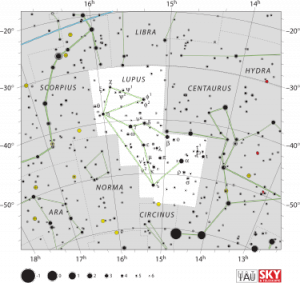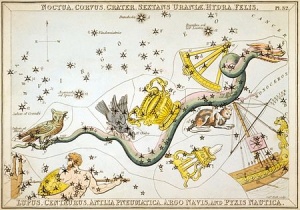Lupus: Difference between revisions
| Line 5: | Line 5: | ||
==History and mythology== | ==History and mythology== | ||
In ancient times, the constellation was considered an asterism within Centaurus, and was considered to have been an arbitrary animal, killed, or about to be killed, on behalf of, or for, Centaurus. An alternative visualization, attested by Eratosthenes, saw this constellation as a wineskin held by Centaurus. It was not separated from Centaurus until Hipparchus of Bithynia named it Therion (meaning beast) in the 200s BC. No particular animal was associated with it until the Latin translation of Ptolemy's work identified it with the wolf. | In ancient times, the constellation was considered an asterism within [[Centaurus]], and was considered to have been an arbitrary animal, killed, or about to be killed, on behalf of, or for, Centaurus. An alternative visualization, attested by Eratosthenes, saw this constellation as a wineskin held by Centaurus. It was not separated from Centaurus until Hipparchus of Bithynia named it Therion (meaning beast) in the 200s BC. No particular animal was associated with it until the Latin translation of Ptolemy's work identified it with the wolf. | ||
[[File:Sidney Hall - Urania's Mirror - Noctua, Corvus, Crater, Sextans Uraniæ, Hydra, Felis, Lupus, Centaurus, Antlia Pneumatica, Argo Navis, and Pyxis Nautica.jpg|thumb|File:Sidney Hall - Urania's Mirror - Noctua, Corvus, Crater, Sextans Uraniæ, Hydra, Felis, Lupus, Centaurus, Antlia Pneumatica, Argo Navis, and Pyxis Nautica.jpg]] | [[File:Sidney Hall - Urania's Mirror - Noctua, Corvus, Crater, Sextans Uraniæ, Hydra, Felis, Lupus, Centaurus, Antlia Pneumatica, Argo Navis, and Pyxis Nautica.jpg|thumb|File:Sidney Hall - Urania's Mirror - Noctua, Corvus, Crater, Sextans Uraniæ, Hydra, Felis, Lupus, Centaurus, Antlia Pneumatica, Argo Navis, and Pyxis Nautica.jpg]] | ||
Latest revision as of 00:05, 22 March 2015
Lupus is a constellation located in the deep southern sky. Its name is Latin for wolf. Lupus was one of the 48 constellations listed by the 2nd century astronomer Ptolemy, and it remains one of the 88 modern constellations, although it was previously an asterism associated with the neighboring constellation Centaurus.
Lupus is bordered by six different constellations, although one of them (Hydra) merely touches at the corner. The other five are Scorpius (the scorpion), Norma (the right angle), Circinus (the compass), Libra (the balance scale), and Centaurus (the centaur). The three-letter abbreviation for the constellation, as adopted by the International Astronomical Union in 1922, is Lup. The official constellation boundaries are defined by an twelve-sided polygon. Covering a total of 334 square degrees, Lupus ranks 46th in area out of the 88 modern constellations.
History and mythology
In ancient times, the constellation was considered an asterism within Centaurus, and was considered to have been an arbitrary animal, killed, or about to be killed, on behalf of, or for, Centaurus. An alternative visualization, attested by Eratosthenes, saw this constellation as a wineskin held by Centaurus. It was not separated from Centaurus until Hipparchus of Bithynia named it Therion (meaning beast) in the 200s BC. No particular animal was associated with it until the Latin translation of Ptolemy's work identified it with the wolf.
Lupus is located in the bottom-left corner of card 32 in Urania's Mirror (1825)
The Greek constellation is probably based on the Babylonian figure known as the Mad Dog (UR.IDIM). This was a strange hybrid creature that combined the head and torso of a man with the legs and tail of a lion (the cuneiform sign 'UR' simply refers to a large carnivore; lions, wolves and dogs are all included). It is often found in association with the sun god and another mythical being called the Bison-man, which is supposedly related to the Greek constellation of Centaurus.
HGS Session References
HGS Sessions - Clearing Hyperspace Phantom Matrix - 3/12/2015 [1]HGS Sessions - Clearing Macau Island, China - 3/21/2015 [2]
References
Found in HGS Manual on Page 108
Found in HGS Manual on Page 115



